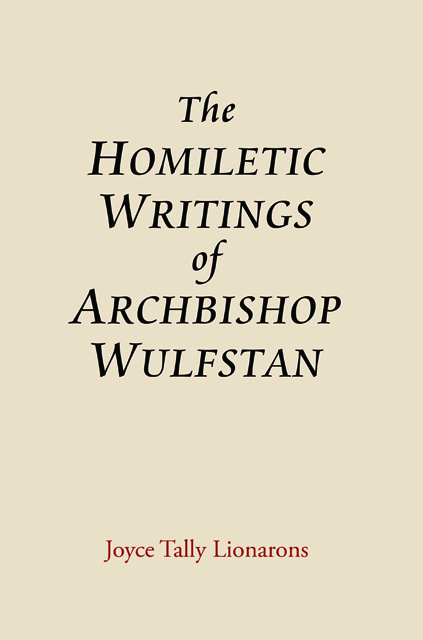Book contents
- Frontmatter
- Contents
- Acknowledgements
- Abbreviations
- Manuscript Sigla
- Introduction
- 1 Wulfstan and Wulfstan Manuscripts
- 2 Re-establishing the Wulfstanian Homiletic Canon
- 3 Wulfstan’s Eschatology
- 4 Salvation History and Christianity
- 5 Wulfstan as Archbishop
- 6 Sacramental Sermons
- 7 The Danish Invasions and the Sermo Lupi ad Anglos
- 8 Homilies Based on Legal Codes and the Institutes of Polity
- Bibliography
- Index
- Miscellaneous Endmatter
2 - Re-establishing the Wulfstanian Homiletic Canon
Published online by Cambridge University Press: 18 February 2023
- Frontmatter
- Contents
- Acknowledgements
- Abbreviations
- Manuscript Sigla
- Introduction
- 1 Wulfstan and Wulfstan Manuscripts
- 2 Re-establishing the Wulfstanian Homiletic Canon
- 3 Wulfstan’s Eschatology
- 4 Salvation History and Christianity
- 5 Wulfstan as Archbishop
- 6 Sacramental Sermons
- 7 The Danish Invasions and the Sermo Lupi ad Anglos
- 8 Homilies Based on Legal Codes and the Institutes of Polity
- Bibliography
- Index
- Miscellaneous Endmatter
Summary
THE MODERN CANON of Wulfstan's homiletic works was established in the 1950s, primarily through the scholarship of Dorothy Bethurum, Dorothy Whitelock, and Karl Jost. In the years following, the canon was generally assumed to comprise only those homilies published in Bethurum's 1957 edition; the additional texts previously printed by Arthur Napier were deemed spurious in terms of authorship or, if authentic, considered to be either variants of Bethurum's texts or simply non-homiletic. In recent years, however, Bethurum's editorial practices have come under increasing criticism as a new generation of scholars has returned to the manuscripts to rediscover familiar works in their material contexts. Such criticism is based less on whatever shortcomings Bethurum may have had as a scholar than in the changes scholarly editing and editorial theory have undergone since the mid-twentieth century; it may therefore serve as an introduction to the effects of editorial theory on the formation of the Wulfstanian homiletic canon, as well as to the impact contemporary editorial theory is having on the re-establishment of the canon today.
The objections to Bethurum's edition are twofold: the first centers around her practice of combining the evidence of several manuscripts in order to create the ‘best’ possible text of a given homily; the second concerns the criteria she uses to determine the inclusion of individual homilies in her edition. The purpose of ‘best text’ editing is to recreate an authorial and thus authoritative text by working backwards from the manuscripts to eliminate scribal ‘corruption’; that is, to strip out interpolations, restore omissions, and correct obvious errors in copying, even if, as often happens, the end result is a textual variant extant in no manuscript at all. The manuscript works themselves are then all too often regarded as debased and corrupted variants of the modern editor's recreated text, with the scribe or scribes who created the manuscripts seen as obstructions in the editor's path to the author's intentions and words. In contrast, contemporary editors and scholars speak of textual indeterminacy – the mouvance that is characteristic of manuscript culture – rather than ‘corruption’, and maintain that traditional editorial practice at best serves only to obscure the mouvance attested by the manuscripts and at worst can verge on falsification of the manuscript evidence.
- Type
- Chapter
- Information
- The Homiletic Writings of Archbishop WulfstanA Critical Study, pp. 23 - 42Publisher: Boydell & BrewerPrint publication year: 2010



